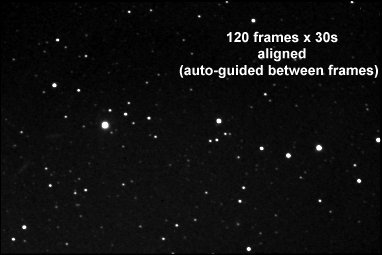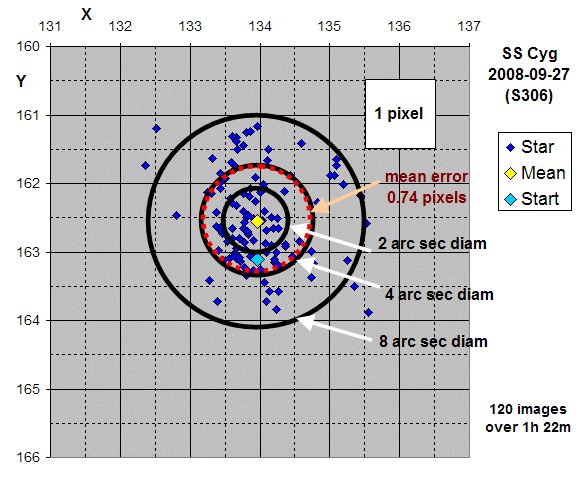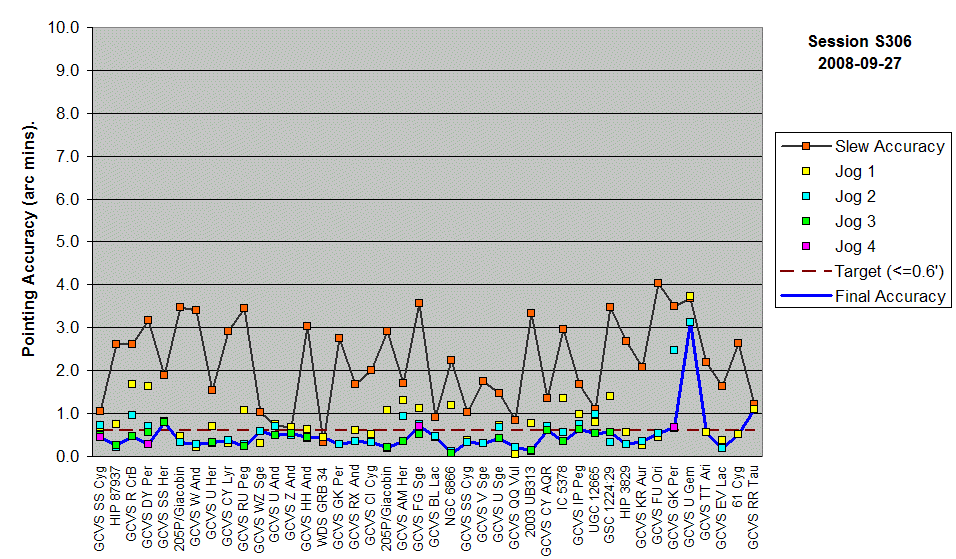David's Astronomy Pages
|
Notes (S305) |
Notes (Main) |
Home Page |
Notes (S310) |
|
Automated Slew, Locate and AutoGuide Analysis of automated guiding performance - SS Cyg Automated Slew & Jog Positioning Performance (S306) >
Newly developed procedures for automatically initiating auto-guiding (autoguide between frames) after a slew/target locate was successfully tested during session S306. Previous autoguiding was initiated manually and switched off manually.
As before user-written routines for identifying and following the brightest star in each image are used with guide (nudge) between frames to keep the frame positioned on the same star-field within 1-2 pixels (2-5 arc secs at my image scale). The routine is robust to passing cloud etc, whereas the standard autoguiding through CCDSoft is not and can lead to the scope trying to guide on noise in 'real world' Scottish conditions.
The results of the tests appear very good, and will allow more automated acquisition of quality time series, for a number of applications requiring long sequences of images : variable star time series (flare stars, eclipsing binaries), exoplanet transits or asteroid/comet tracking.
The purposes of auto-guiding between frames are 4- fold
The target object remains appropriately centered and doesn't wander to one side
Stacked images / animations will be able to
use the full AOI of the image
(if there is uncorrected star drift
then the area of full frame coverage is successively
reduced with time, black panels appear on the sides of
stacked images reducing
the 'live' area and necessitating cropping for
presentation)
Comparison or check stars located near the
edge of the image area, will remain in view for the whole session
(if comparison or check stars drift
near the edge or out of the frame then photometric analysis will not be
possible
manual intervention/re-centering is not always convenient
and can produce a time gap in the data)
Variable Star and Comparison & check
stars remain positioned on the same part of the image through the session
leading to more accurate photometric data
(if variable and comparison stars
drift across the frame through the session, the results of photometric
analysis are much more affected by the quality of the
flat frame and any uncorrected vignetting across the star field.
Previous analysis has shown that it is difficult to
produce perfect flat frames and even then they may not correct
light variation across the frame if there is sag in the
imaging system (due to a heavy camera !)
Keeping stars located on or near identical pixels through
the run should reduce the impact of uneven lighting.
An analysis of the automated guiding urposes of auto-guid
Back to Top
Automated guiding between frames was active during a time series run from SS Cyg, involving run of 120 frames (30s exposures) over a 82 minute period.
Routines automatically selected the brightest
star in the image as the guide star (GSC 3196:701, Mag +8.5)
An position error threshold of 0.5 pixels relative to the first image was used
to make trigger guide corrections.
Analysis of 120 frames from SS Cyg over a 82
minute run showed that the average pointing error from the mean star position
was 0.74 pixels This is equivalent to 1.8 arc secs. This contrasts
with an average FWHM of 3.5 arc secs over the run.
Based on overall drift rate between frames when guide corrections were not
triggered, then the amount of star drift across the 82 minute run would
have been 58 pixels, equivalent to 2.4 arc minutes. This would have
significantly compromised the ability to carry out an automated long time series
if no guide correction was employed.
| Qualitative Analysis
of autoguiding performance |
| Image below shows
simple stacking of 120 frames from a 1h 22m duration run of SS Cyg No alignment of images has been performed. Apart from slight bloating of stars there is clearly no star drift (Unguided there would be noticable star drift over an interval of 82 minutes) |
 |
|
Stacked CCD Image (Non-Aligned) 120 x 30s exposure (average combine), 2x2 binning, V filter, 2008-09-27 23:53h UT (#306232-351) |
| Image below shows
aligned image stacking of the 120 frames Alignment of images has been performed. The stars are sharper in this image compared to the non-aligned image above. but the difference is not that great and shows the obvious success of autoguiding between frames |
 |
| Stacked CCD Image (Aligned before
stacking) Image details as above |
| Quantitative Analysis of automated guiding performance |
 |
Back to Top
Analysis of data from session S306 shows that
Pointing Error after slews was consistently less than 4 arc minutes (P50 2.1 arc
mins, mean 2.2 arc mins), with final pointing error after jog positioning
consistently less than 0.6 arc minutes (P50 0.4 arc mins).
See earlier analysis of
Slew and Jog Positioning performance from session S297-S305
| Graph showing analysis of Automated Slew/Locate Positioning performance (2008-09-27, S306) |
 |
Back to Top
| This Web Page: | Notes - Session 306 (2008-09-27) |
| Last Updated : | 2015-05-16 |
| Site Owner : | David Richards |
| Home Page : | David's Astronomy Web Site |